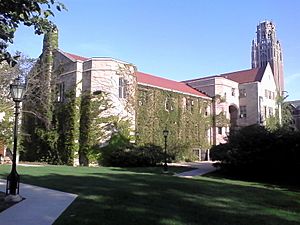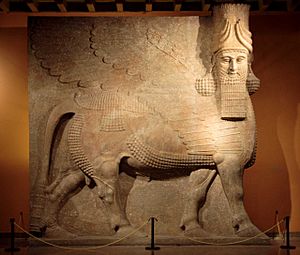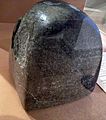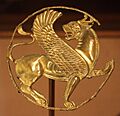Institute for the Study of Ancient Cultures facts for kids
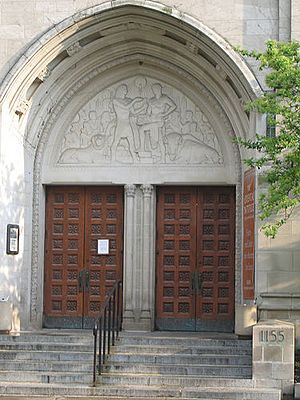
East Meets West tympanum, designed in 1931 by sculptor Ulric Ellerhusen
|
|
| Established | 1919 |
|---|---|
| Location | University of Chicago 1155 E 58th Street Chicago, Illinois |
| Type | Archaeology; languages |
The Institute for the Study of Ancient Cultures, West Asia & North Africa (ISAC) is a special place at the University of Chicago. It used to be called the Oriental Institute. This institute is a research center and a museum that studies ancient civilizations from the Near East. This area includes places like Egypt, Iraq, and Iran.
ISAC was started in 1919 by a professor named James Henry Breasted. He studied ancient Egypt and history. He got money from John D. Rockefeller Jr. to create it. The institute does research on old civilizations across the Near East. It also has a huge collection of ancient objects and discoveries that visitors can see in its museum in Hyde Park, Chicago. Experts say ISAC's collection of items from the Near East is one of the best in the world.
Contents
History of the Institute
In the early 1900s, James Henry Breasted was building up the collection for the university's Haskell Oriental Museum. He also did field work and taught classes. But he had a bigger dream: to create a research center. He wanted this center to be a "laboratory" to study how civilization began and grew. He believed Western civilization had its roots in the ancient Middle East.
As World War I was ending, Breasted saw a chance to make his dream happen. He thought the time was right to get access to ancient sites for study. He wrote to John D. Rockefeller Jr. and suggested creating what would become the Oriental Institute. To start, Breasted planned a research trip through the Middle East. He believed the area was ready for scholars again after the war. Rockefeller agreed to give $50,000 over five years for the new institute. He also promised another $50,000 to the University of Chicago's president. The university added its own support, and so, in May 1919, the Oriental Institute was officially founded.
The institute is located in a beautiful building that looks like an old castle. It's at the corner of 58th Street and University Avenue. The building was designed by the architects Mayers Murray & Phillip. Starting in 1996, the building was made bigger and updated. This work took several years. For example, the roof was completely replaced between 2000 and 2001. To help pay for this, the institute allowed people to write messages in ancient languages on 250 of the new roof tiles.
The building was finished in 1930 and officially opened in 1931. A German American sculptor named Ulric Ellerhusen created a special carving above the entrance called East Meets West. This carving shows important figures from both the East and the West. From the East, you can see a lion, Zoser, Hammurabi, Thutmose III, Ashurbanipal, Darius the Great, and Chosroes. From the West, there's a bison, Herodotus, Alexander the Great, Julius Caesar, a crusader, and an archaeologist.
In the 1990s, Tony Wilkinson started the 'Center for Ancient Middle Eastern Landscapes' at the institute. This center uses landscape archaeology to study the Middle East. They look at maps, old aerial photos, and modern satellite images. This helps them understand how ancient people lived in their environments.
Why the Name Changed
In the 2010s, many groups in the U.S. started thinking about the word "Oriental." Some scholars felt this word was old-fashioned and could be hurtful. They also felt its meaning had changed. In March 2023, the University of Chicago announced they would change the name of the Oriental Institute. The interim director, Theo van den Hout, explained that the old name caused confusion. People often thought their work was about East Asia, not West Asia and North Africa. Also, the word "oriental" had become a negative term in modern English.
In April 2023, the organization's name officially changed to the Institute for the Study of Ancient Cultures, West Asia & North Africa, or ISAC for short. The institute's new logo features a lotus flower. This flower is important because it appears in ancient art from Assyria, Mesopotamia, and Egypt. It is also a decoration on the ISAC building itself.
Research and Amazing Collections
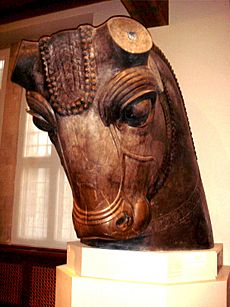
The ISAC Museum has many amazing objects found during digs in places like Egypt, Israel, Syria, Turkey, Iraq, and Iran. Some famous items in their collection include the Megiddo Ivories. These are beautiful carvings made from ivory. They also have treasures from Persepolis, which was the old capital of Persia. You can see a collection of Luristan Bronzes, which are ancient metal objects.
One of the most impressive items is a huge 40-ton statue of a Lamassu. This is a mythical creature with the body of a bull or lion, eagle wings, and a human head. It came from the palace of Sargon II. There is also a giant statue of King Tutankhamun from ancient Egypt. The museum is free to enter, but visitors are encouraged to make a donation.
The Institute for the Study of Ancient Cultures is a very active place for research on the ancient Near East. The upper floors of the building have a library, classrooms, and offices for professors. The museum's gift shop, called the Suq, sells books for university classes about the Near East. Besides doing many archaeological digs in the Fertile Crescent, ISAC scholars have helped us understand how human civilization began. The term "Fertile Crescent" was actually created by J. H. Breasted. He helped people understand the link between the rise of civilization in the Near East and the development of European culture.
In 2011, ISAC scholars finished publishing the 21-volume Chicago Assyrian Dictionary. This huge dictionary is a key reference for understanding ancient Assyrian culture. The project started way back in 1921 with J. H. Breasted. Erica Reiner led the research teams for 44 years. Other similar dictionaries are also being created, like the Chicago Hittite Dictionary and the Chicago Demotic Dictionary.
Chicago House in Egypt
The Institute also manages the work of Chicago House in Luxor, Egypt. This facility in Egypt was set up in 1924. It performs the Epigraphic Survey, which means they carefully record and study the ancient writings and carvings at historical sites in Luxor. They also help preserve these important sites.
Ancient Persian Tablets Lawsuit
In 2006, the Oriental Institute was involved in a legal case. A U.S. federal court wanted to take and sell a valuable collection of ancient Persian tablets held by the museum. The money from the sale would go to help victims of a 1997 bombing in Jerusalem. The U.S. claimed Iran had funded this attack. This ruling threatened the sale of these priceless ancient clay tablets. The Oriental Institute had them since the 1930s, but they are owned by Iran.
These Achaemenid (or Persepolis) clay tablets were loaned to the University of Chicago in 1937 for study. American archaeologists from the university found them in Persepolis, Iran, in 1933. They legally belong to the National Museum of Iran and Iran's Ministry of Cultural Heritage. The tablets were loaned with the understanding that they would be returned to Iran. The institute had been returning them in groups over the years. These tablets are from Persepolis, the capital of the Achaemenid Empire, and date back to around 500 BCE.
The tablets show us what daily life was like back then. They list things like the daily food given to workers in different parts of the empire. These records were sent to the capital to keep track of worker payments. Gil Stein, a former director of the Oriental Institute, said the details mostly cover food for people on diplomatic or military trips. Each tablet is about half the size of a deck of playing cards. They have writing in a dialect of Elamite, an extinct language that only about a dozen scholars in the world can understand.
Stein said the tablets give us "the first chance to hear the Persians speaking of their own empire." Charles Jones, a research associate and librarian at the Oriental Institute, compared them to "credit card receipts." Most of what we know about the ancient Persian empire comes from other sources, like the Greek storyteller Herodotus. Stein added that the collection is very valuable because it's thousands of tablets from the same archive. It's like having the same filing cabinet. The Oriental Institute had been returning them to Iran in small groups. Since the 1930s, they had sent back hundreds of tablets and pieces. They were getting ready for another shipment when the lawsuit started. Later, an appeals court stopped the order to seize the tablets. In 2018, the United States Supreme Court confirmed that the collection cannot be taken from the Institute to pay for the judgment.
Directors of ISAC
- 1919–1935: James Henry Breasted; the first director
- 1936–1946: John A. Wilson
- 1950–1960: Carl Hermann Kraeling
- 1962–1968: Robert McCormick Adams Jr.
- 1968–1972: George R. Hughes
- 1972–1981: John A. Brinkman
- 1981–1983: Robert McCormick Adams Jr. (second time)
- 1983–1989: Janet H. Johnson
- 1989–1997: William Marvin Sumner
- 1997–2002: Gene B. Gragg
- 2002–2017: Gil Stein
- 2017–2021: Christopher Woods
- 2021–2023: Theo Van Den Hout (Interim Director)
- 2023–Present: Timothy P. Harrison
Images for kids
-
Reconstructed headstone from Persepolis
-
A colossal statue of Tutankhamun from ancient Egypt
See also
 In Spanish: Instituto Oriental de Chicago para niños
In Spanish: Instituto Oriental de Chicago para niños


